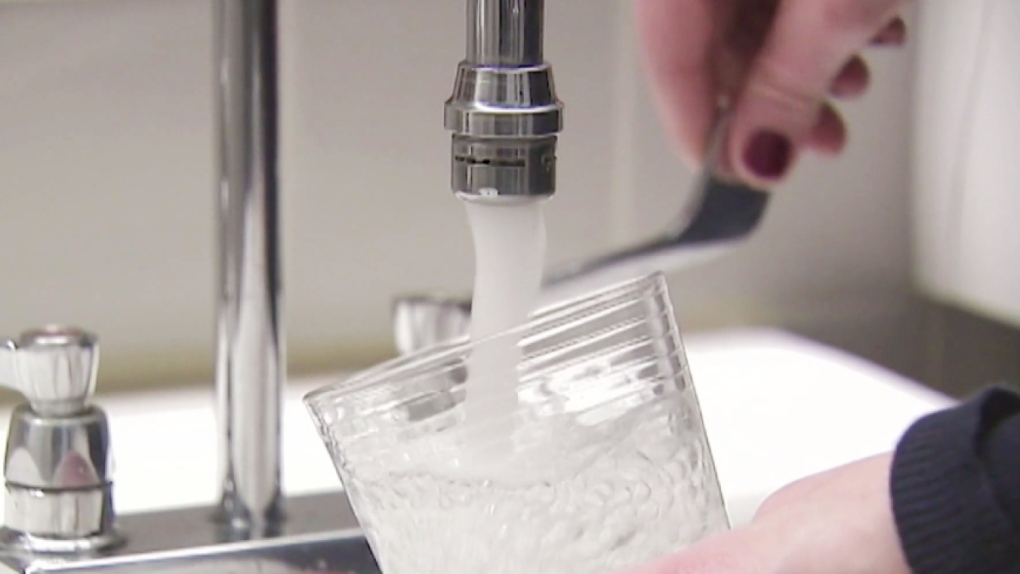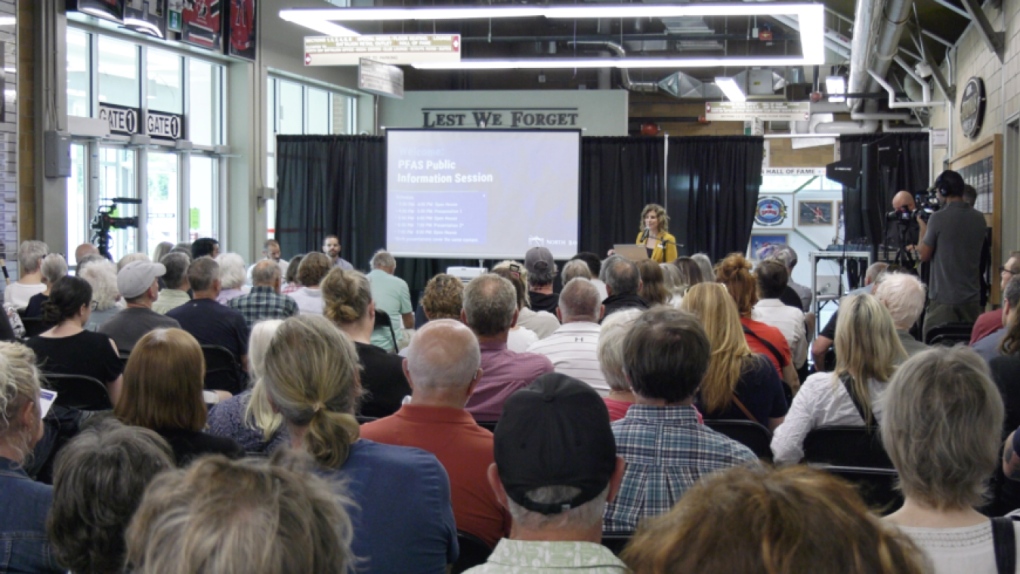North Bay residents express concerns over PFAS in municipal water drinking supply
The City of North Bay, along with the Department of National Defence, Ministry of the Environment and North Bay Parry Sound District Health Unit held information sessions late Thursday afternoon and evening to update the public on the per- and polyfluoroalkyl substances (PFAS) at the Jack Garland Airport.
PFAS are a large, complex group of synthetic chemicals that have been used in consumer products around the world since about the 1950s.
PFAS are known as ‘forever chemicals’ that were first detected by the health unit in December 2016.
Packing Memorial Gardens with their questions, anxious residents are wondering why a meeting of this magnitude about PFAS in their drinking water is finally happening years after the initial discovery.
“We are glad that the city has put this together because the word has been going around for a couple of years now,” said resident Tom McLeod.
More than 200 people took in the session, where an update was provided on remediation work.
The “PFAS hotspot,” according to the city, is on the airport lands. The property was used for firefighter training from the mid-1970s to the late 1990s.
The substances were in firefighting foam and seeped into the soil, moving through groundwater into Lee's Creek.
That waterway is connected to Trout Lake, which is where North Bay draws its drinking water supply.
“I want to know what's happening at the water treatment system plant in North Bay, how that is going to be changed and what filter system is going to go in there,” said Trout Lake Conservation Association board member Carol Hansman.
 The City of North Bay, along with the Department of National Defence, Ministry of the Environment and North Bay Parry Sound District Health Unit held information sessions late Thursday afternoon and evening to update the public on PFAS at the Jack Garland Airport. (Eric Taschner/CTV News)
The City of North Bay, along with the Department of National Defence, Ministry of the Environment and North Bay Parry Sound District Health Unit held information sessions late Thursday afternoon and evening to update the public on PFAS at the Jack Garland Airport. (Eric Taschner/CTV News)
'Everybody drinks their water from Trout Lake'
“I go to a restaurant, I drink a glass of water, and in hospitals, schools, businesses, everybody drinks their water from Trout Lake.”
Brennain Lloyd, project co-ordinator with the environmental group called Northwatch, said the information session leaves her with many more questions about how the cleanup is going to take place.
“It isn’t over until we have drinking water that is not contaminated or not contaminated to a level that can reasonably expect a harmful outcome,” Lloyd said.
Current scientific research suggests that exposure to certain PFAS may be harmful to human health.
Toxicology reports have identified the following health effects as potential outcomes from exposure to PFAS:
• Changes in cholesterol and liver enzyme levels.
• Small changes in infant birth weight.
• Changes in the immune system and response to certain vaccines.
• Increased risk of preeclampsia or high blood pressure in pregnant women.
• Increased risk for certain cancers
The levels detected, however, remain lower than the current drinking water screening values set out by Health Canada.
 The City of North Bay, along with the Department of National Defence, Ministry of the Environment and North Bay Parry Sound District Health Unit held information sessions late Thursday afternoon and evening to update the public on PFAS at the Jack Garland Airport. (Eric Taschner/CTV News)
The City of North Bay, along with the Department of National Defence, Ministry of the Environment and North Bay Parry Sound District Health Unit held information sessions late Thursday afternoon and evening to update the public on PFAS at the Jack Garland Airport. (Eric Taschner/CTV News)
Health Canada guidelines
In 2017, the Ministry of Environment developed an interim advice value for PFAS in drinking water.
It determined there should be 70 nanograms per litre, equivalent to around 3.5 drops in an Olympic-sized swimming pool. Those are based on a guideline from Health Canada.
But Health Canada is currently proposing a new limit of 30 nanograms per litre for the total sum of all PFAS measured in drinking water. North Bay's drinking water would exceed that level.
The city and the DND have a $20 million agreement in place to address the substance remediation at the airport. The DND will cover $19.4 million for the studies, removal, and remediation.
“By working together, we're going to get a solution that's going to be right for everyone,” said Saleem Sattar, director general of environment and sustainability with the DND.
“So it's going to take time, but we're going to do it right.”
After bringing in an environmental consulting firm, the city revealed it is close to going to tender on the project and is hoping to have shovels in the ground in the fall to begin the work.
“I just hope something gets resolved about this rather quickly. I hope money is not an issue. People's health is more important,” said resident Claude Brunette.
The work includes removing and treating contaminated soil. To restrict more PFAS from getting into the environment, a barrier would be installed.
“I don't want to say necessarily that our first phase of remediation is going to necessarily fix everything,” said Karin Pratte, North Bay’s senior environment and facilities engineer.
“It will remove PFAS from the airport site and it will aid downstream. Now, the amount that it will be supporting downstream, that we need to monitor.”
A long-standing drinking water advisory for Lee’s Creek remains in place. There’s also a fish consumption advisory in place for fish from the creek.
CTVNews.ca Top Stories

Tensions run high on the Hill as MPs debate second Conservative motion of non-confidence
Members of Parliament debated the second Conservative motion of non-confidence in Prime Minister Justin Trudeau's government of the week on Thursday, amid simmering tensions.
WATCH LIVE Helene strengthens to a Category 4 hurricane as it nears Florida's Gulf Coast
Helene strengthened into a Category 4 hurricane hours ahead of its expected landfall on Florida's northwest coast Thursday night, and forecasters warned that the enormous storm could create a 'nightmare' surge in coastal areas and bring dangerous winds and rain across much of the southeastern U.S.
Canadian rapper K'naan charged with sexual assault following arrest in Quebec City
Canadian singer K'naan has been charged with sexual assault after being arrested by police in Quebec City.
Cold case arrest: Nunavut RCMP charge man with murder in 1986 death of teenage girl
Mounties in Nunavut have made an arrest in the murder of a 15-year-old girl almost 40 years ago.
Air Canada flight to Toronto diverts due to emergency
An Air Canada flight headed to Toronto from Frankfurt diverted to Edinburgh due to an emergency Thursday, the airline says.
Mounties in B.C. warn 'highly convincing' scammers extorting victims with photos of their homes
Scammers are increasingly using emails to extort money from victims by threatening to reveal compromising photos, videos and personal information to their friends and family members, according to a new warning from Mounties in Metro Vancouver.
'It's a big pizza': Edmonton pizzeria selling pie that can feed up to 60 people
A pizza chain in Edmonton claims to have the world's largest deliverable pizza.
Montana man arrested for intentionally running a motorcycle off the road and killing the driver
A Montana man has been arrested after witnesses said he intentionally and repeatedly swerved his car at three motorcycles in south-central Montana, running one off the road and killing its driver, officials in Carbon County said.
Alabama puts man convicted of killing 3 to death in the country's second nitrogen gas execution
Alabama used nitrogen gas Thursday to execute a man convicted of killing three people in back-to-back workplace shootings, the second time the method that has generated debate about its humaneness has been used in the country


































